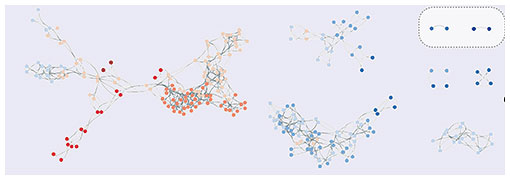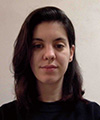 |
|||||
|
|
|||||
|
Short Reports Vol. 19, No. 3, pp. 68–71, Mar. 2021. https://doi.org/10.53829/ntr202103sr1 Simulating Complex Quantum Networks with Time Crystals1. IntroductionResearchers at the National Institute of Informatics (NII), NTT, Osaka University, the Japanese-French Laboratory of Informatics (JFLI), and Tokyo University of Science have discovered that time crystals can be used to simulate complex quantum networks. Crystals are widely present in our daily life in the form of solid materials, the atoms of which self-organize in regular patterns. While these arrangements tend to be periodic in space, a newly discovered type of matter also shows such regularity in the dimension of time. These exotic systems are called time crystals and can only be observed under special circumstances. Although recent developments in quantum technology and the excellent controllability of quantum devices now allow researchers to explore time crystals in the laboratory, little is known about their properties and applications. This article, first published in Science Advances [1], focuses on the application of tools commonly used in network theory to represent these systems that allows for a deeper understanding of their structures. With this, researchers were able to represent the melting of a time crystal in terms of networks and found the emergence of special type of structures: scale-free networks. These complex networks have the same structural properties as today’s Internet or airplane networks. Therefore, having a physical system that allows for its efficient simulation in the lab has enormous implications in the technology arena. 2. BackgroundTypical crystals emerge in nature as the atoms that form a solid arrange themselves in a periodic regular structure. When this occurs, a continuous translation symmetry of free space is broken, as the system is no longer invariant under the arbitrary translations of its atoms. The breaking of such a translation symmetry can also be done in the temporal dimension, giving raise to time crystals. A recent example of this phenomenon is presented as a twice the time discrete time crystal (2T-DTC). An arrangement of interacting two-level systems (such as spins) are under a periodic external drive that repeats at every time T. Time-translation symmetry breaking occurs when the dynamical response of the 2T-DTC shows a different periodicity than the external drive, as it needs 2T to go back to its initial position. 3. Research resultsThis research shows that complex network structures, such as scale-free networks illustrated in Fig. 1, emerge from slowly melting a 2T-DTC. The authors of this article used a model of a DTC that can be experimentally constructed and showed that its structure can be melted by adding an error to the drive (which plays the role of increasing temperature). Marta Estarellas from NII stated that, “Aided by a network visualization technique, for the first time we shed new light on the mechanisms by which the time crystal melts.” Victor Bastidas from NTT added that, “It became clear that, with an increasing value of error, the melting of the time crystal behaves like a phase transition, something similar to the way crystals, such as a block of ice, typically melt.”
4. MethodsUsing Floquet theory, one can capture the periodic nature of time crystals and obtain information of the system at the relevant discrete points of its quantum dynamics. William Munro from NTT stated that, “We represented this information in terms of networks using a percolation rule and analyzed how its connectivity changes as the time crystal melts due to an error in the drive.” The use of their network visualization technique made it possible to observe the temporal connection of the time crystal’s quantum states for the first time, allowing them to extract information on the properties of the crystal by analyzing the properties of the crystal’s associated network. 5. OutlookQuantum computers exhibit enormous power even if they are small. Time crystals also present this advantage as they can embed exponentially large networks using a small time-crystal device. Marta Estarellas stated that, “Potential applications of our results include the use of time crystals as a quantum simulator to analyze the structure of very large complex networks present in our daily lives, something that in the classical world would otherwise be impossible as it would require a huge amount of computing resources.” Kae Nemoto from NII added that, “Put it this way, using this method and with just several qubits one could simulate a complex network of the size of the entire worldwide Internet.” Their introduced techniques proved networks to be a valuable tool to represent quantum complex systems, something that will surely aid in the future study and understanding of quantum many-body systems. 6. FundingThis research has been made possible thanks to the support of the Japanese Ministry of Education, Culture, Sports, Science and Technology Quantum Leap Flagship Program (MEXT Q-LEAP) JPMXS0118069605, the MEXT KAKENHI Grant-in-Aid for Scientific Research on Innovative Areas Science of Hybrid Quantum Systems grant no.15H05870, and the JSPS KAKENHI grant no. 19H00662. This project was also made possible through the support of a grant from the John Templeton Foundation (JTF 60478)*.
Reference
Researcher’s commentFinding Real Applications for Current Quantum Devices
Marta P. Estarellas Quantum mechanics has had a huge impact on many areas of science by providing a whole new mathematical framework that helped — and keeps helping — us to enhance our knowledge of nature in a very accurate way. This theory is so powerful that its applications have soon reached the information science arena, giving rise to what could be — if not yet — a new technological revolution. The fast development of quantum technology has brought the field of quantum computing into the era of noisy intermediate-scale quantum (NISQ) devices. Proving quantum supremacy in such quantum devices has become a race between large academic institutions and companies. Their main focus is to attain the quantum advantage from the universal computation point of view. It is however unlikely that, with their current size and error rates, NISQ devices will be able to outperform conventional computers. Under the QLEAP umbrella, NII and NTT Basic Research Laboratories are pursuing the quantum advantage proof from a different perspective: thinking of NISQ devices as dedicated systems. In our collaboration, we focus on the design of small-scale quantum devices with hardware-specific applications that surpass the current classical technology, without the need of granting for universality. With this aim, we have successfully proposed DTCs as dedicated quantum computers to simulate and analyze the structure of very large complex networks present in our daily lives, something that in the classical world would otherwise be impossible as it would require a huge amount of computing resources. Researcher’s commentMelting Time Crystals to Simulate Networks on Small Quantum Computers
Victor M. Bastidas Crystals, such as salt and diamonds, are periodic arrays of atoms in space that are pretty common in our daily life. It has recently been demonstrated that time can be crystalized as well and the corresponding state of matter is known as a discrete time crystal (DTC). In contrast to spatial crystals, DTCs break discrete translational symmetry and time. They are rigid and robust against small perturbation and remain stable for a long time, as solid crystals do. Although DTCs are extremely popular in research and for the general public, practical applications of this exotic state of matter are lacking. In October 2020, we proposed a scheme to use DTCs to simulate a large-scale network. Our work is published in the American Journal Science Advances and will open a new avenue of research in the field of time crystals. We showed the possibility to simulate large networks with an exponential number of nodes by using small quantum devices. This achievement was obtained through joint research with M. P. Estarellas and Prof. K. Nemoto from NII, T. Osada and Prof. K. Sanaka from Tokyo University of Science, B. Renoust from Osaka University, and W. J. Munro from NTT Basic Research Laboratories under the QLEAP program. Our work not only proposes an application of DTCs but opens a new direction of research. We envision that the methods and techniques developed from our work will inspire further research on global properties of systems out of equilibrium and their intimate relation with networks. For inquiries:Public Relations, NTT Science and Core Technology Laboratory Group |
|||||











